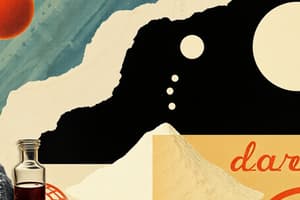Podcast
Questions and Answers
Match the anion with the correct test and result:
Match the anion with the correct test and result:
Chloride (Cl⁻) = Acidify the solution with dilute nitric acid (HNO₃) and add a few drops of aqueous silver nitrate (AgNO₃). White precipitate of silver chloride (AgCl) is the positive result. Bromide (Br⁻) = Follow steps 1 and 2 from Chloride testing. Pale cream precipitate of silver bromide (AgBr) is the positive result. Iodide (I⁻) = Follow steps 1 and 2 from Chloride testing. Yellow precipitate of silver iodide (AgI) is the positive result. Sulfate (SO₄²⁻) = Add a few drops of barium chloride (BaCl₂) or barium nitrate (BaNO₃) solution to the test solution. White precipitate of barium sulfate (BaSO₄) is the positive result.
Match the anion with its solubility property:
Match the anion with its solubility property:
Chloride (Cl⁻) = Soluble in water and dilute acids. Bromide (Br⁻) = Soluble in water but slightly soluble in dilute acids. Iodide (I⁻) = Slightly soluble in water and dilute acids. Carbonate (CO₃²⁻) = Insoluble in water and dilute acids.
Match the anion with its distinguishing interfering anions:
Match the anion with its distinguishing interfering anions:
Chloride (Cl⁻) = Interfering Anions: Bromide (Br⁻) and Iodide (I⁻) (distinguished by precipitate color). Bromide (Br⁻) = Interfering Anions: Iodide (I⁻) (distinguished by precipitate color). Iodide (I⁻) = Nitrate (NO₃⁻) =
Match the anion with the correct reagent for testing:
Match the anion with the correct reagent for testing:
Match the anion with the observed reaction during testing:
Match the anion with the observed reaction during testing:
Flashcards are hidden until you start studying




